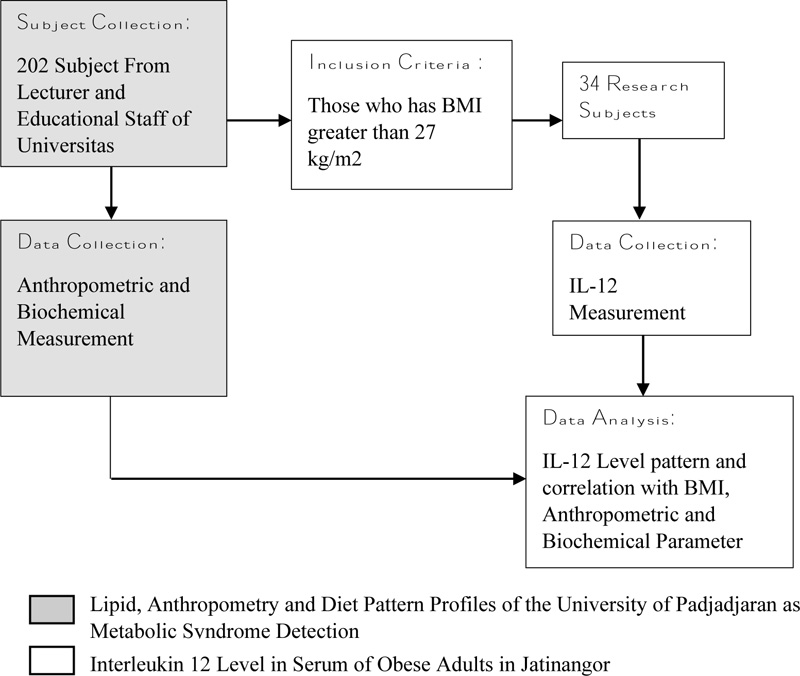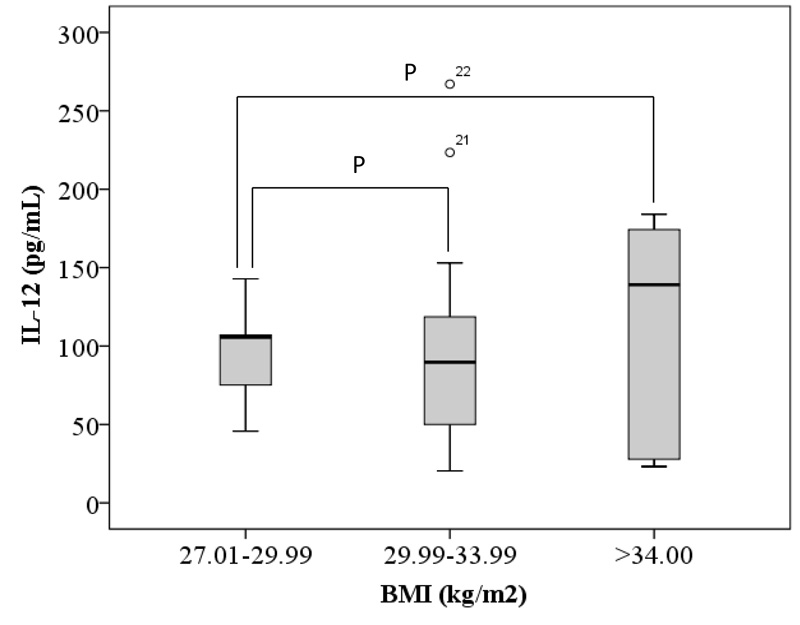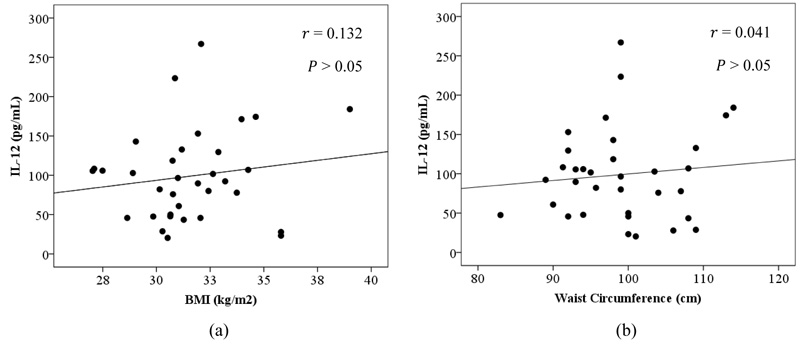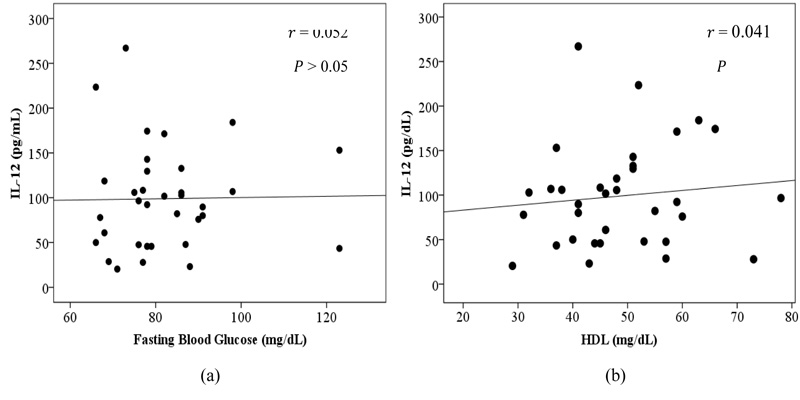All published articles of this journal are available on ScienceDirect.
The Influence of Aquarobic Training Towards Interleukin 12 (IL-12) Plasma Level and Its Correlation with Obesity
Abstract
Objective:
Interleukin 12 (IL-12) has been of interest during the advancement of insulin obstruction in stout mice. Serum IL-12 levels have not precisely been decided in obese people and neither is its regulation by aquarobic training (recommended sport type for obese people which is less stressor for hefty individual joints).
Aims:
This research aims to discover the alteration pattern of IL-12 in serum of obese people based on BMI, examine their relationship with obesity-related parameters and how it can be modulated by aquarobic training.
Methods:
First study wasa cross-sectional study conducted on 34 obese adults ranging from 33 – 57 years old. The study used primary data which were blood samples from adult obese. For reducing the risk for the obese patients, in second study, we recruited 12 healthy volunteers for a 12 week aquarobic training program. Using enzyme-linked immunosorbent assay (ELISA) methods, we observed that serum IL-12 level was altered by different levels of BMI and correlated with other factors like Low Density Lipoprotein level, Cholesterol level and Waist Ratio.
Results:
The group with BMI between 27.01 – 29.99, have IL-12 level of 94.102 ± 35.19 pg/mL. Group with BMI 30.00 – 33.99 have 96.068 ± 59.44pg/mL, and those with BMI more than 33.99 have IL-12 level of 114.572 ± 74.22 pg/mL.
Conclusion:
Interestingly, it was observed that 12 week aquarobic training can significantly reduce the IL-12 level. Taken together, IL12 level may play an important role in obesity and can be potentially modulated by aquarobic training.
1. INTRODUCTION
Obesity is a general medical issue that has turned out to be a pestilence worldwide and 40 millions of individuals on the planet have a hefty or overweight issue [1]. Albeit hereditary variables impact obesity, but diet and physical movement decide whether an individual inevitably winds up hefty or not. Organized physical exercise preparing can improve or keep up body wellness to control weight [2]. Obesity, as a way of life issue, is essentially coming about because of an irregularity between the vitality admission and its use which is appeared by exorbitant Adipose tissue affidavit. In weight, changes of adipokines and a few further cytokines are thought to add to an aggravation procedure [3, 4]. Previous proof has set up the pathogenesis of those clutters with a foundational second rate provocative state, described by an expansion in the coursinglevels of a few master incendiary inflammation go-betweens, for example, tumor necrosis factor-alpha (TNF-α), interleukin-6 (IL-6) [6], and IL-12 [5,6,7]. IL12 is basically one of the heterodimeric pro-inflammatory cytokines which is generally delivered by dendritic cells and phagocytes, that instigates the generation of interferon-γ which is significant for the separation of T aide 1 cells and structures a connection between inborn opposition and versatile invulnerability. IL-12 has been, as of late, proposed to include during improvement of heftiness related insulin obstruction in rodents, IL-12p40 quality articulation increments in both the epididymal fat tissue and fat tissue macrophages in high-fat eating routine nourished mice [9, 10]. All things considered, serum IL-12 levels have not been correctly decided in subjects with a high metabolic hazard. We, therefore, evaluated circulating levels of IL-12 in obese individuals, examining their correlation with obesity-related anthropometric and biochemical parameters.
Exercise is a stressor for the body, the body is compelled to perform more exercises than expected and answer for controlling corpulence by decreasing fat tissue affidavit (11, 12, 13). It is trying to locate the best sport strategy for hefty people which may not be ready to perform practice as normal people. Aquarobic may wind up as one of the best answers for stout people to adjust with the heap of activity preparing program (14). In the previous two decades, high-impact water exercises or water-based exercises become as an elective exercise program to accomplish wellness and rehabilitation purposes for people who physically experienced issues in practicing ashore [15, 16]. Along these lines, aquarobic may turn into a decent choice for preparing a corpulent person, who has issues in executing customary activities ashore because of the trouble of supporting their very own weight and help diminish their metabolic disorder hazard.
Taken together, our investigation reveals a potential connection between IL12 with obesity and IL12 levels with aquarobics. IL12 level might be associated with an increment in BMI and possibly by aquarobic training.
2. MATERIALS AND METHOD
2.1. Non Training Subject
This study was a descriptive analytical one with a cross-sectional design. Participants have been interviewed for secondary anthropometric data and Diet Pattern Profiles. Blood samples were collected from antecubital vein, put on ice and stored in -20C until use. Blood Biochemical examination was performed for measuring lipid levels Fig. (1). Inclusion criteria of study participant are those who are obese (Body Mass Index (BMI) > 27 kg/m2). The Ethical Approval was obtained from Ethic Committee of Faculty of Medicine, Universitas Padjadjaran with Number: 1389/ UN6.KEP/ EC/ 2018.
2.2. Aquarobic Training Subject
Initial subject examination was conducted at the beginning of training program. Twelve people were divided into 2 groups: Control and Aquarobic Training. These groups were isolated and prepared in Swimming Sport Center, Universitas Negeri Semarang, Central Java, Indonesia. Aquarobic training protocolis explained point by point in Supplementary Fig. (3) (17, 18). Polar sensors (pulse screen) were used to monitor the pulse. Blood samples were collected in pre-test estimations from the onset day before treatment. Post-test was performed at the last meeting of the activity following 12 weeks from pre-test for the same subject. All participants were well informed about procedures and advantages according to the Ethics committee of Universitas Negeri Semarang.
2.3. Anthropometric Measurement
The majority of the participants were separated into three groups: group 1 (BMI 27.01–29.9 kg/m2), group 2 (BMI 30–39.99 kg/m2), and group 3 (BMI ≥ 34 kg/m2), in which Body Mass Index (BMI) is the consequence of isolating load by stature squared (kg/m2). Midsection circumference of body was acquired from each subject, (considering the midpoint between the lower rib edge and iliac peak), utilizing a regular tape in centimeters (cm).
2.4. Blood Biomarker
Three ml of blood sample was taken from fossa cubitti vein using Ethylenediaminetetraacetic acid (EDTA) vacutainer, A few drops were directly used for measuring Fasting Blood Glucose, Triglyceride, and High Density Lipoprotein Levels according to the manufacturer protocols (Accutrend Plus GCT meter, Germany). Rest of the sample was centrifuged at a speed of 12.000 rpm at 4°C for 10 min. Serum was kept at -80°C until use for measuring IL-12 levels .
2.5. IL-12 Measurements
Collected Blood samples were put in EDTA tube and homogenized. Gathering cylinders were then centrifuged at 10.000 g in 4°C for 30 min. Serum samples were acquired and stored at −80ºC prior the use. Serum levels of IL-12 were measured using enzyme-linked immunosorbent assay (ELISA) technique, according to the Manufacture Protocol (Invitrogen, Thermoscientific, USA). Data was measured using Tecan Infinite 200 PRO (Lifescience tech., Switzerland).
2.6. Statistical Analysis
The data was presented as mean ± standard deviation by using one-way ANOVA followed by a post hoc test for defining the significant differences. Statistical analysis was conducted by using SPSS software version 21 (SPSS Inc., Chicago, IL, USA) and p <0.05 was considered significant.
3. RESULTS
Total of 34 subjects were incorporated into the examination, separated into three groups, 7 in group 1 (BMI 27.01-29.99), 21 in group 2 (BMI 30.00-33.99), and 6 in group 3 (BMI >34.00). No huge contrasts were seen in age (Group 1, mean age 50 ± 4.62 years; Group 2, mean age 47.05 ± 5.03 years; Group 3, mean age 47 ± 7.46 years). Abdomen circuit, muscle versus fat ratio, fasting blood glucose, and triglyceride focus demonstrated an expansion in overweight and large individuals as contrasted and ordinary weight controls (Table 1).
| - | BMI | P | ||
| 27.01 – 29.99a | 30.00 – 33.99b | >34.00c | ||
| Gender (W/M) | 2 / 5 | 13 / 8 | 6 / 0 | |
| Age (Years) | 50 ± 4.62 | 47.05 ± 5.03 | 47 ± 7.46 | |
| BMI (Kg/m2) | 28.29 ± 1.09 | 31.52 ± 1.01 | 35.58 ± 1.85 | b,c P < 0.001 |
| Waist Circumference (cm) | 93.54 ± 6.3 | 98.7 ± 6.04 | 106.33 ± 6.83 | b,c P 0.001 < P < 0.05 |
| HDL (mg/dL) | 45.14 ± 8.23 | 47.48 ± 11.12 | 56.67 ± 14.24 | b,c P > 0.05 |
| Fasting Blood Glucose (mg/dl) | 79.57 ± 4.58 | 81.71 ± 16.15 | 86.83 ± 9.48 | b,c P > 0.05 |
We determined that the group that has a midriff outline exceeding 100 cm (1 subject in group 1, 8 subjects in group 2, and 4 subjects in group 3) Fig. (3) (an) and the LDL/HDL proportion more than 3.5 (7 subject in group 1, 7 subjects in group 2, and 1 subject in group 3) Fig. (3b) have a critical contrast from one another gathering. BMI, serum levels of IL-12 displayed an expansion in group 3 and group 2 when contrasted with group 1 (P>0.05) Fig. (2).
The mean estimation of IL-12 in group 3 is 114.572 ± 74.22, group 2 is 96.068 ± 59.44, while in the group 1, it is 94.102 ± 35.19.
In anthropometric parameters, BMI and midriff boundary enlarge, flowing degrees of IL-12 likewise expanded in the investigation populace. This outcome was positive yet not noteworthy for the relationship between serum IL-12 and BMI (r = 0.132, P > 0.05) Fig. (3a), just as IL-12 and midsection outline (r = 0.041, P > 0.05) Fig. (3b), Furthermore, flowing centralizations of IL-12 demonstrated a positive, however, not critical connection with other weight related biochemical parameters, including fasting blood glucose (r = 0.052, P = P > 0.05) Fig. (4a) and HDL (r = 0.149, P > 0.05) Fig. (4b).





Aquarobic training additionally had a huge impact on IL-12 serum level (p < 0.05). The value of IL12 level for control group is 96,629 ± 7,9378 and for the aquarobic treatment group is 67,524 ± 3,7751 Figs. (5 and 6).

4. DISCUSSION
Even though genetic factors impact heftiness/obesity, diet and physical activity decide whether an individual, in the long run, winds up fat. Organized physical exercise can improve or keep up body wellness and lessen obesity [1]. The impact of activity on the body that happens because of activity is dictated by the power of the activity, the force of the gentle to direct exercise is profoundly suggested in fat individuals, just as in high force exercise coming about various impact [11-13].
Obesity, as a way of life issue, is just coming about because of an irregularity between vitality admission and use which is appeared by unreasonable fat tissue testimony. In obesity, adjustments of adipokines and a few further cytokines are thought to add to an aggravation procedure [5-7], and have endeavored to name this incendiary state as metaflammation, which means metabolically activated irritation. Weight instigated aggravation might be best depicted as metaflammation: a constant, second rate fiery reaction started by abundance of supplements in metabolic cells. The incendiary flagging, led by the metabolic cell in the long run, makes initiation of particular safe cells and leads to an uncertain fiery reaction inside the tissues [5].
IL-12 is one of the most delegate individuals from the Th1 cytokine family, with surely understood capacities in prompting generation of IFN-γ and separation of sort 1 T cells, advancing, thusly, a linkage between intrinsic reaction and versatile resistance. For the most part, IL-12 is delivered by monocytes, macrophages, dendritic cells, neutrophils and to a lesser degree, B cells [9]. A few components have been recognized as adding to corpulence related irritation that subsequent increment cytokine and interleukin creation. Hyperplasic and hypertrophic adipocytes incorporate master provocative adipokines, macrophages relocate into the fat tissue, where polarization from M2 to M1 macrophages is upgraded, where the TH2/TH1 proportion and TReg cell movement is diminished. These procedures are needed to prompt a move in cytokine levels from cytokines with anti-inflammatory properties to pro-inflammatory cytokines in obesity [19, 20]. Therefore, obesity may potentially alter the IL12 level Fig. (2). Interestingly, we also observed that IL12 level has significant correlation with waist circumference and with HDL/LDL ratio as well, p<0,06 Fig. (3).
Latest trial proof from high-fat-diet-bolstered mice proposes that IL-12 could have an extra job in the foundational poor quality irritation and corpulence related issue, for example, insulin opposition [21]. Thus, it is of much importance to ponder the fundamental degrees of IL12 in people that show high metabolic hazard, for example, corpulent people. It has been recently announced that flowing centralizations of IL-12 are altogether expanded in subjects with a metabolic disorder [9]. Our information shows that the circling levels of IL-12 has positive association with obesity, one of the key elements to create an issue include metabolic disorder and type 2 diabetes. Curiously, IL-12 was likewise expanded, however, not critically with parameters of heftiness/ obesity, which is weight list (BMI) Fig. (3). By arranging the information dependent on indicated midsection circuit and LDL-HDL proportion, we investigated critical contrast from three groups. On the other hand, it additionally uncovered a few subjects that have exceptionally abnormal state of IL-12 yet don't have high midsection boundary just as high LDL/HDL proportion, further investigation with greater example is required. There are a few elements that affected the generation of cytokines, explicitly for IL-12 like contamination [10]. Unexpectedly, there is no significant association between IL-12 and fasting blood glucose level in obese subjects Fig. (4). Further investigations utilizing a bigger number of samples and scope of samples like: pre diabetic, and diabetic obese subjects, are essential for a progressively precise assurance of the relationship of IL-12 with insulin opposition in humans.
Physical exercise need to be done consistently for stimulating body fitness. However, in some specific conditions, like individuals with overweight conditions or obese, specific type of exercise is required. Obese individuals usually have limitation with mobility. The obese person may not achieve the expected target of a high intensity exercise. Therefore, high intensity exercise without weight support consideration will increase joint injury and is not recommended, as it can cause damage particularly to the knee joint and lower leg as a result of over weight [12, 13]. We believe that specific exercise may modulate the IL12 levels. In this highlight, aquarobics type trainings have numerous positive results for the patient, from wellness segment to physiological angles [15, 16]. Obesity may prompt ceaseless low irritation when supplement abundance draws in insusceptibility tangible through physiological supplement actuated pressure taken to limits that initiates resistant reaction pathways [19, 20]. Improved lipid profile is a significant finding in post aquarobic training (lower fat/supplement in the body), insusceptible reaction will diminish and result in lower aggravation level [22, 23]. Exercise is fitting and prescribed according to the state of weight even in the water sports [14]. To reduce the risk of the study, we designed and performed second study utilizing a person who has a normal BMI to evaluate the effect of aquarobics training on IL12 baseline levels. Aquarobics type exercise is safe for obesity because it reduces the mechanical stress to the knee joint and prevent injury from falling down. The aquarobics protocols is performed by keeping the chest area straight, knee position ought to be raised higher and like kicking water, this development enables the body to remain upstanding so water running development should be possible as running ashore [17, 18, 23]. Interestingly, our data had showed that baseline level of IL-12 serum was lowered after 12 weeks aquarobic training compared to the control group Fig. (6).
IL12 has significant correlation with an increase in waist ratio and IL12 is significantly decreased with aquarobics training for 12 weeks. Potentially, IL-12 might have a correlation with an increase of LDL/HDL (p<0,066).
CONCLUSION
Taken together, our investigation has shown that serum levels of IL-12 are higher in people with a higher BMI (higher comorbidities chance). Furthermore, serum levels of IL-12 demonstrate a positive association with weight related markers in anthropometric and potentially with some biochemical parameters (LDL/HDL), but not with fasting blood glucose levels. Interestingly, aquarobic training is an ideal training protocol for obese people as it lowers IL-12 levels in the serum.
ETHICS APPROVAL AND CONSENT TO PARTICIPATE
The Ethical Approval was obtained from Ethic Committee of Faculty of Medicine, Universitas Padjadjaran with Number: 1389/ UN6.KEP/ EC/ 2018.
HUMAN AND ANIMAL RIGHTS
No animals were used in this study. Reported experiments on humans were in accordance with the ethical standards of the committee responsible for human experimentation (institutional national), and with the Helsinki Declaration of 1975, as revised in 2008.
CONSENT FOR PUBLICATION
Written informed consent was obtained from all the patients.
AVAILABILITY OF DATA AND MATERIALS
Not applicable.
FUNDING
This work was supported by PDUPT from Indonesian Ministry Research, Technology and Higher Education Grant No:3854/UN6.C/2019 to Ronny Lesmana (2019).
CONFLICT OF INTEREST
The author declares no conflict of interest, financial or otherwise.
ACKNOWLEDGEMENTS
Declared none.
SUPPLEMENTARY MATERIAL
Supplementary material is available on the publishers web site along with the published article.


